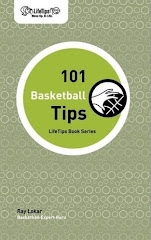Quite often basketball games are decided by the team that gets the most "easy" shots. A good way to prevent your opponent from getting these easy shots is to improve your teams TRANSITION DEFENSE. There are a number of different transition defense philosophies that vary in the amount of immediate pressure the defense puts on the basketball. These range from "jamming" the rebounder by pressuring him right away with the closest man and getting into an immediate full court press to everyone simply sprinting back to the defensive end. Different styles may be chosen based on the qualities that your team possesses and it’s ability to apply defensive pressure. One of the safest ways to protect against easy fast break baskets is to remember the phrase, "BASKET-BALL-MAN"
The phrase, "BASKET-BALL-MAN" refers to the order of protection when retreating on defense. The first player back on defense must protect the BASKET. This will prevent the easiest of shots and limit the number of fast break layups the opponent may get. Once the basket is protected, the next player back needs to stop the BALL. After the BASKET is protected and the BALL is pressured, then players can feel free to match up and find their appropriate MAN or responsibility. The most important transition basket to try to prevent is the open, "breakaway layup", when the offensive player is even or slightly ahead of the transition defender. Let’s talk about four steps to preventing this breakaway layup.
1) STOP THE BALL
When hustling to sprint back and prevent a breakaway layup, the first option should always be to get back and establish a legal guarding position. Maybe you can contain the ball before it even gets into shooting range.
2) TAKE THE CHARGE
If you acquire position near the basket before the shooter leaves the ground for the layup attempt, try to get set and get an offensive foul on the shooter. Taking a CHARGE on a player about to get a sure basket is one of the best ways of changing some momentum to your team
3) STRIP OR SWIPE
When a defender is too late to get set to take a charge, an overlooked technique is to STRIP or SWIPE at the ball while running past the offensive player directly thru his path as he drives for the layup. The defender must avoid all contact and try to steal or deflect the ball as they run by. Many times, the mere act will cause the shooter to lose concentration and either travel or miss the shot.
4) CONTEST OR BLOCK THE SHOT
As a last resort try to CONTEST or BLOCK the shot at the point in which it is directed. The defense should wait and time the attempt until the ball is out of the shooters hand and approaching the backboard. We call it "meeting the shot at the glass". Trying to block the shot out of a shooters hand might result in a foul, although many times that foul may be to a teams advantage. Rather than giving up an almost certain two points, a team may wish to "make the player earn it" by forcing them to make two foul shots instead. If a team is going to foul, they should foul for an advantage and make certain that the shooter does not make the layup AND get a free throw (And1). Most important in this is to avoid "hard fouls" or those that may be dangerous or cause injury.
GET READY FOR GAME 7
-
The Indiana Pacers avoided an end to their season beating the New York
Knicks Friday night in Indy, 116-103. The series is tied 3-3. Game 7 is
Sunday, 3:30...
9 hours ago









